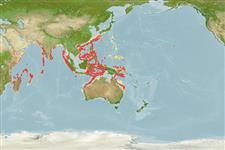Environment: milieu / climate zone / depth range / distribution range
Ökologie
seewasser; brackwasser benthopelagisch; tiefenbereich 143 - 820 m (Ref. 9784). Deep-water; 34°N - 27°S, 40°E - 155°E (Ref. 6181)
Indo-West Pacific: Mozambique Channel, Saya de Malha Bank, Maldives Islands, India, Sri Lanka, Arafura and Java seas, Makassar Strait, northwestern and northeastern Australia and southern Japan (Ref. 6181). Also recorded from New Caledonia (Ref. 33346).
Size / Gewicht / Alter
Maturity: Lm ? range ? - ? cm
Max length : 22.0 cm SL Männchen/unbestimmt; (Ref. 9784)
Rückenflossenstacheln (insgesamt): 19 - 20; Rückenflossenweichstrahlen (insgesamt): 14-16; Afterflossenstacheln 2; Afterflossenweichstrahlen: 11 - 13; Wirbelzahl: 34. Spinescent gill rakers with 3 or 4 cusps. Lateral line branching from below the 5th to before the 6th spine of the first dorsal fin; the upper lateral line reaching at least to the end of the soft dorsal fin base.
Matures at about 10 cm standard length. A squid was found in the stomach of one specimen (Ref. 9784).
Life cycle and mating behavior
Geschlechtsreife | Fortpflanzung | Ablaichen | Eier | Fecundity | Larven
Nakamura, I. and N.V. Parin, 1993. FAO Species Catalogue. Vol. 15. Snake mackerels and cutlassfishes of the world (families Gempylidae and Trichiuridae). An annotated and illustrated catalogue of the snake mackerels, snoeks, escolars, gemfishes, sackfishes, domine, oilfish, cutlassfishes,. scabbardfishes, hairtails, and frostfishes known to date. FAO Fish. Synop. 125(15):136 p. (Ref. 6181)
IUCN Rote Liste Status (Ref. 130435)
Bedrohung für Menschen
Harmless
Nutzung durch Menschen
Fischereien: kleinfischerei
Mehr Information
NamenSynonymeMetabolismusRäuberÖkotoxikologieFortpflanzungGeschlechtsreifeAblaichenSpawning aggregationFecundityEierEientwicklung
ReferenzenAquakulturAquakultur ProfilZuchtlinienGenetikElectrophoresesVererbbarkeitKrankheitenVerarbeitungNutrientsMass conversion
PartnerBilderStamps, Coins Misc.LauteCiguateraGeschwindigkeitSchwimmstilKiemenoberflächeOtolithsGehirngrößeSehfähigkeit
Tools
Zusatzinformationen
Download XML
Internet Quellen
Estimates based on models
Preferred temperature (Ref.
123201): 8.8 - 17.3, mean 11.7 °C (based on 319 cells).
Phylogenetic diversity index (Ref.
82804): PD
50 = 0.5078 [Uniqueness, from 0.5 = low to 2.0 = high].
Bayesian length-weight: a=0.00363 (0.00163 - 0.00807), b=3.10 (2.91 - 3.29), in cm total length, based on LWR estimates for this (Sub)family-body shape (Ref.
93245).
Trophic level (Ref.
69278): 4.5 ±0.37 se; based on food items.
Widerstandsfähigkeit (Ref.
120179): hoch, Verdopplung der Population dauert weniger als 15 Monate. (Preliminary K or Fecundity.).
Fishing Vulnerability (Ref.
59153): Low vulnerability (17 of 100).
